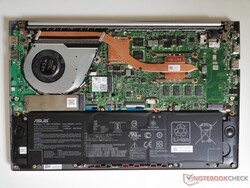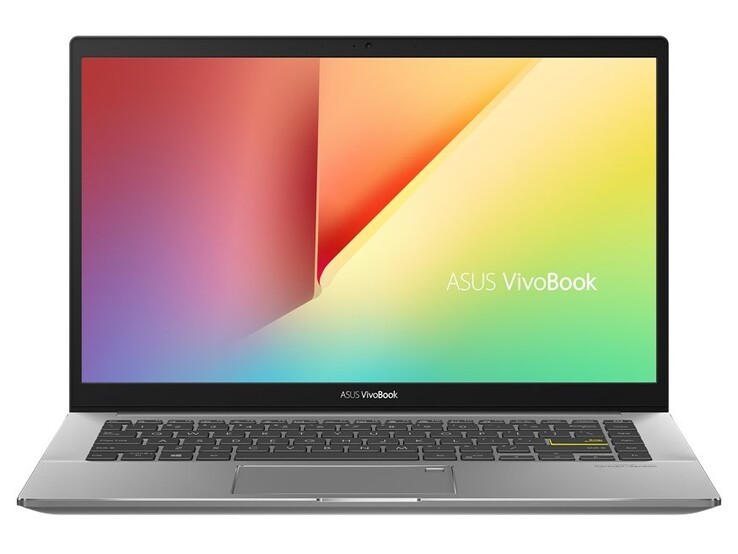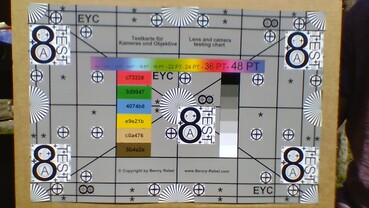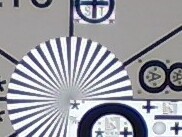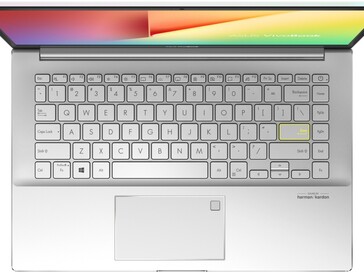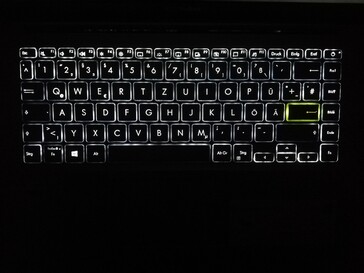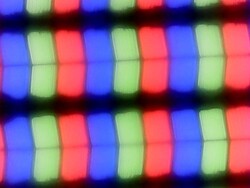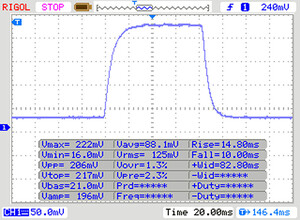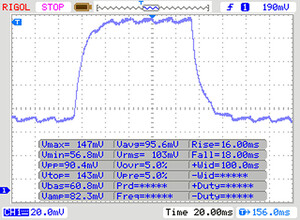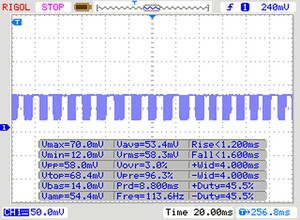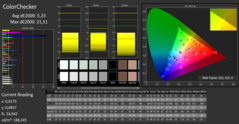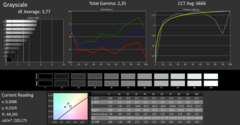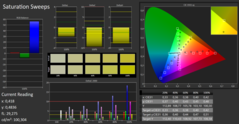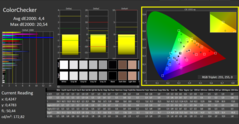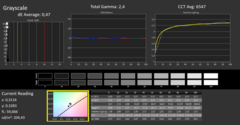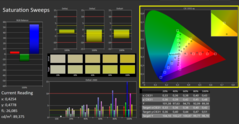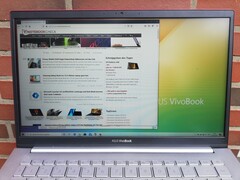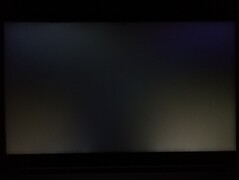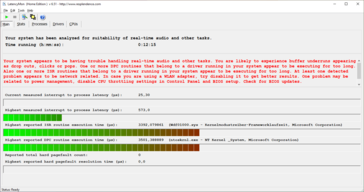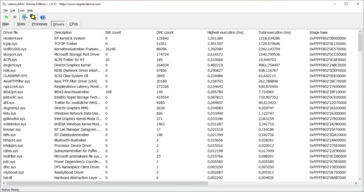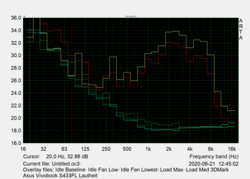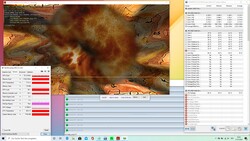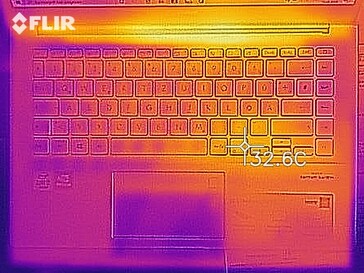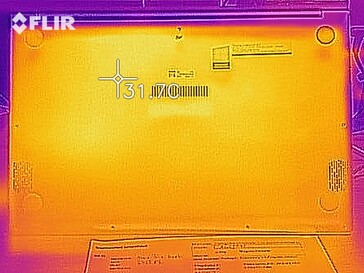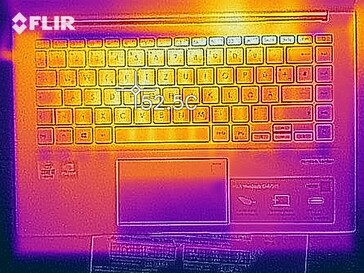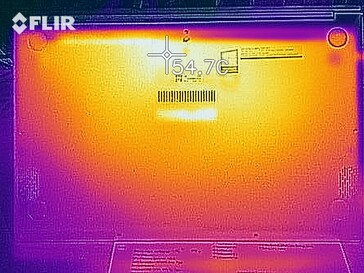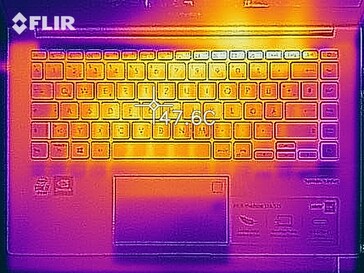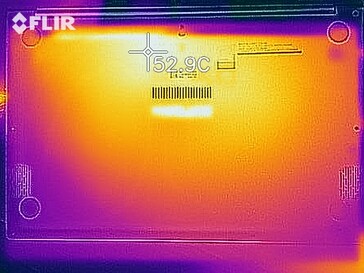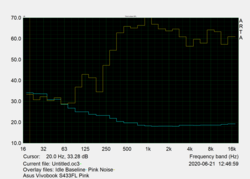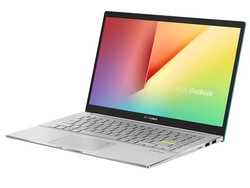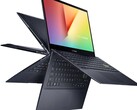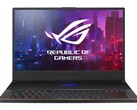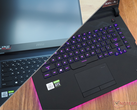Asus VivoBook S14 S433FL in review: Colorful laptop with stable case
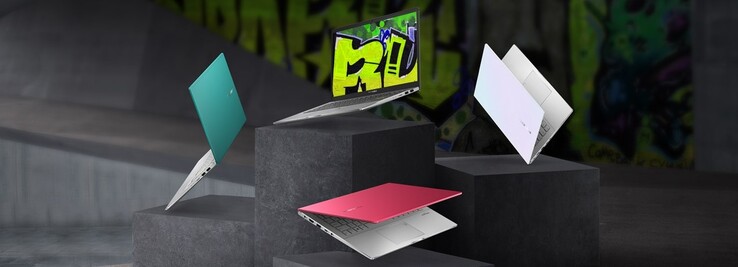
The laptops in the VivoBook series cover a wide price range and include affordable office laptops, such as the Asus VivoBook 15 F512D, and also slim mobile models like the Asus VivoBook 14 X403FA. The Asus VivoBook S14 S433FL presents itself as a slim lifestyle laptop and is tested here in its best configuration. We also compare the 14-inch laptop to the competitors listed below, to which further laptops from our database can be added.
Rating | Date | Model | Weight | Height | Size | Resolution | Price |
|---|---|---|---|---|---|---|---|
| 80.7 % v7 (old) | 07 / 2020 | Asus VivoBook S14 S433FL i7-10510U, GeForce MX250 | 1.4 kg | 16 mm | 14.00" | 1920x1080 | |
| 86.5 % v7 (old) | 06 / 2020 | Acer Swift 3 SF314-42-R4XJ R7 4700U, Vega 7 | 1.2 kg | 16.55 mm | 14.00" | 1920x1080 | |
| 85.6 % v7 (old) | 04 / 2020 | Schenker VIA 14 i5-10210U, UHD Graphics 620 | 1.1 kg | 16.5 mm | 14.00" | 1920x1080 | |
| 77.8 % v7 (old) | 01 / 2020 | HP Pavilion 14-ce3040ng i7-1065G7, GeForce MX250 | 1.6 kg | 18 mm | 14.00" | 1920x1080 |
Case and connectivity - Stable Asus laptop with Wi-Fi 6
Asus uses metal in the VivoBook S14's case, which makes the laptop look very stable. The workmanship is high quality, and there are no uneven gaps or similar in our test model. Buyers can also choose between different colors, which Asus calls Gaia Green, Resolute Red, Indie Black, and Dreamy White. If the screws on the laptop's bottom are loosened, the bottom cover can be removed. This will allow you to access the storage device, but the other components are firmly installed.
The VivoBook S14 has a microSD card reader, which achieves comparatively slow read and write speeds with our Toshiba Exceria Pro M501 reference memory card. On WLAN, we measure good speeds with our Netgear Nighthawk AX12 reference router, but these don't correspond to the full potential of the built-in Wi-Fi 6 module. Users have access to a 0.9 MP webcam for video chats and the like. It illuminates our ColorChecker Passport brighter than it should be and shows blurred details even in good light.
Port configuration
| SD Card Reader | |
| average JPG Copy Test (av. of 3 runs) | |
| Average of class Multimedia (21.1 - 198, n=40, last 2 years) | |
| Schenker VIA 14 | |
| HP Pavilion 14-ce3040ng (Toshiba Exceria Pro SDXC 64 GB UHS-II) | |
| Asus VivoBook S14 S433FL (Toshiba Exceria Pro M501 microSDXC 64GB) | |
| maximum AS SSD Seq Read Test (1GB) | |
| Average of class Multimedia (27.4 - 262, n=40, last 2 years) | |
| Schenker VIA 14 (Toshiba Exceria pro M501 64 GB UHS-II) | |
| HP Pavilion 14-ce3040ng (Toshiba Exceria Pro SDXC 64 GB UHS-II) | |
| Asus VivoBook S14 S433FL (Toshiba Exceria Pro M501 microSDXC 64GB) | |
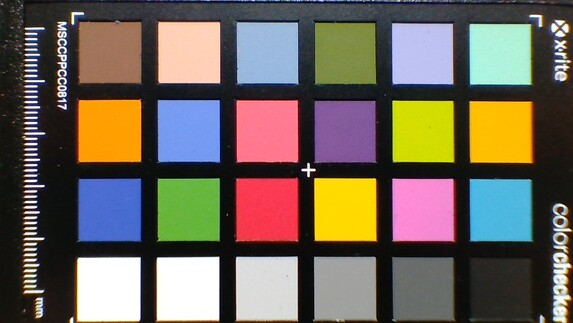
Input devices - 14-inch laptop with keyboard backlighting
The keyboard of the Asus VivoBook S14 has a three-level backlight, which users should only activate in low-light conditions, though. The white light and the silver keys cause the labeling, which is actually easy to read during the day, to not be recognizable otherwise. When typing, all keys are within easy reach, but the feedback is a bit soft. The keyboard is very quiet in return.
A ClickPad is available as a mouse replacement, with which the mouse pointer can be navigated well. Clicks triggered both by touch and mechanical pressure are reliably recognized. In our test configuration, Asus has installed a fingerprint scanner in the upper right corner of the pad, which responds reliably to saved fingerprints. Buyers who can do without this sensor get the integrated number pad instead. Both functions are not available at the same time, though.
Display - Good contrast but weak colors
The Asus VivoBook S14's screen consists of a 14-inch IPS panel and offers a resolution of 1920x1080 pixels. The maximum brightness of 238 cd/m² is at the lower end of our test field. The same applies to the brightness distribution of 68%. However, we were able to detect PWM at a brightness of under 20%, which could lead to problems for users with sensitive eyes due to its low frequency of 250 Hz.
| |||||||||||||||||||||||||
Brightness Distribution: 68 %
Center on Battery: 216 cd/m²
Contrast: 1419:1 (Black: 0.155 cd/m²)
ΔE ColorChecker Calman: 5.23 | ∀{0.5-29.43 Ø4.78}
calibrated: 4.4
ΔE Greyscale Calman: 3.77 | ∀{0.09-98 Ø5}
62% sRGB (Argyll 1.6.3 3D)
40% AdobeRGB 1998 (Argyll 1.6.3 3D)
42.99% AdobeRGB 1998 (Argyll 3D)
62% sRGB (Argyll 3D)
41.55% Display P3 (Argyll 3D)
Gamma: 2.35
CCT: 6666 K
| Asus VivoBook S14 S433FL Chi Mei CMN14D4, IPS, 1920x1080, 14" | Acer Swift 3 SF314-42-R4XJ AU Optronics B140HAN04.0, IPS, 1920x1080, 14" | Schenker VIA 14 B140HAN06.2, a-Si AHVA-IPS LED, 1920x1080, 14" | HP Pavilion 14-ce3040ng AUO543D, IPS, 1920x1080, 14" | |
|---|---|---|---|---|
| Display | -10% | 65% | 59% | |
| Display P3 Coverage (%) | 41.55 | 37.2 -10% | 69.8 68% | 66.5 60% |
| sRGB Coverage (%) | 62 | 55.9 -10% | 99.6 61% | 98.4 59% |
| AdobeRGB 1998 Coverage (%) | 42.99 | 38.43 -11% | 71.6 67% | 68.2 59% |
| Response Times | -13% | -63% | -51% | |
| Response Time Grey 50% / Grey 80% * (ms) | 34 ? | 41 ? -21% | 60.8 ? -79% | 60.8 ? -79% |
| Response Time Black / White * (ms) | 24 ? | 25 ? -4% | 35.2 ? -47% | 29.6 ? -23% |
| PWM Frequency (Hz) | 250 ? | |||
| Screen | 3% | 44% | 27% | |
| Brightness middle (cd/m²) | 220 | 269 22% | 335 52% | 395 80% |
| Brightness (cd/m²) | 204 | 244 20% | 309 51% | 375 84% |
| Brightness Distribution (%) | 68 | 83 22% | 84 24% | 91 34% |
| Black Level * (cd/m²) | 0.155 | 0.23 -48% | 0.17 -10% | 0.26 -68% |
| Contrast (:1) | 1419 | 1170 -18% | 1971 39% | 1519 7% |
| Colorchecker dE 2000 * | 5.23 | 4.94 6% | 2.3 56% | 5.92 -13% |
| Colorchecker dE 2000 max. * | 21.51 | 20.37 5% | 5 77% | 9.79 54% |
| Colorchecker dE 2000 calibrated * | 4.4 | 5.03 -14% | 1 77% | 0.91 79% |
| Greyscale dE 2000 * | 3.77 | 1.71 55% | 3.9 -3% | 6.69 -77% |
| Gamma | 2.35 94% | 2.52 87% | 2.19 100% | 2.78 79% |
| CCT | 6666 98% | 6535 99% | 6556 99% | 7596 86% |
| Color Space (Percent of AdobeRGB 1998) (%) | 40 | 35 -12% | 65.5 64% | 63 58% |
| Color Space (Percent of sRGB) (%) | 62 | 56 -10% | 99.6 61% | 98 58% |
| Total Average (Program / Settings) | -7% /
-2% | 15% /
35% | 12% /
23% |
* ... smaller is better
Display Response Times
| ↔ Response Time Black to White | ||
|---|---|---|
| 24 ms ... rise ↗ and fall ↘ combined | ↗ 14 ms rise | |
| ↘ 10 ms fall | ||
| The screen shows good response rates in our tests, but may be too slow for competitive gamers. In comparison, all tested devices range from 0.1 (minimum) to 240 (maximum) ms. » 53 % of all devices are better. This means that the measured response time is worse than the average of all tested devices (20.2 ms). | ||
| ↔ Response Time 50% Grey to 80% Grey | ||
| 34 ms ... rise ↗ and fall ↘ combined | ↗ 16 ms rise | |
| ↘ 18 ms fall | ||
| The screen shows slow response rates in our tests and will be unsatisfactory for gamers. In comparison, all tested devices range from 0.165 (minimum) to 636 (maximum) ms. » 45 % of all devices are better. This means that the measured response time is similar to the average of all tested devices (31.6 ms). | ||
Screen Flickering / PWM (Pulse-Width Modulation)
| Screen flickering / PWM detected | 250 Hz | ≤ 20 % brightness setting | |
The display backlight flickers at 250 Hz (worst case, e.g., utilizing PWM) Flickering detected at a brightness setting of 20 % and below. There should be no flickering or PWM above this brightness setting. The frequency of 250 Hz is relatively low, so sensitive users will likely notice flickering and experience eyestrain at the stated brightness setting and below. In comparison: 53 % of all tested devices do not use PWM to dim the display. If PWM was detected, an average of 8118 (minimum: 5 - maximum: 343500) Hz was measured. | |||
Our measurements show that the Asus laptop has a good contrast ratio of 1,419:1 and a very good black value of 0.155 cd/m². The color-space coverage is only average at 62% (sRGB). Out of the box, the panel displays colors with too much green and too little red. However, this situation can almost be completely evened out through calibration. The corresponding ICC file can be downloaded in the window located at the top, to the right of the display's brightness distribution graph.
Moreover, the IPS panel is very stable in terms of viewing angles and only shows a low degree of screen bleeding. Despite the comparatively low brightness, the VivoBook S14 can be used well outdoors as long as users prioritize places in the shade. Due to the matte screen surface, mirroring and reflections don't pose a problem.
Performance - Up to many tasks
Asus isn't only aiming at office users with the VivoBook S14 S433FL, but it also enables applications with a somewhat higher demand on graphics performance with the use of the Nvidia GeForce MX250 GPU. In addition, there are two configurations for the RAM, two for the CPU, and two for the storage. The variant tested here represents the best possible configuration.
Processor
In our test configuration, an Intel Core i7-10510U and 16 GB of RAM ensure a smooth system operation. The processor achieves results that are on par with other laptops that we have reviewed with this CPU. During our Cinebench R15 endurance test, however, we found that the performance drops by about 12% after a short time and is then maintained at this level.
Cinebench R15: CPU Single 64Bit | CPU Multi 64Bit
Blender: v2.79 BMW27 CPU
7-Zip 18.03: 7z b 4 -mmt1 | 7z b 4
Geekbench 5.5: Single-Core | Multi-Core
HWBOT x265 Benchmark v2.2: 4k Preset
LibreOffice : 20 Documents To PDF
R Benchmark 2.5: Overall mean
| Cinebench R20 / CPU (Single Core) | |
| Average of class Multimedia (420 - 853, n=60, last 2 years) | |
| HP Pavilion 14-ce3040ng | |
| Acer Swift 3 SF314-42-R4XJ | |
| Asus VivoBook S14 S433FL | |
| Average Intel Core i7-10510U (362 - 497, n=37) | |
| Schenker VIA 14 | |
| Cinebench R20 / CPU (Multi Core) | |
| Average of class Multimedia (1887 - 11924, n=60, last 2 years) | |
| Acer Swift 3 SF314-42-R4XJ | |
| HP Pavilion 14-ce3040ng | |
| Asus VivoBook S14 S433FL | |
| Average Intel Core i7-10510U (1015 - 1897, n=38) | |
| Schenker VIA 14 | |
| Cinebench R15 / CPU Single 64Bit | |
| Average of class Multimedia (99.6 - 323, n=63, last 2 years) | |
| HP Pavilion 14-ce3040ng | |
| Acer Swift 3 SF314-42-R4XJ | |
| Average Intel Core i7-10510U (113 - 202, n=42) | |
| Asus VivoBook S14 S433FL | |
| Schenker VIA 14 | |
| Cinebench R15 / CPU Multi 64Bit | |
| Average of class Multimedia (856 - 5224, n=66, last 2 years) | |
| Acer Swift 3 SF314-42-R4XJ | |
| Schenker VIA 14 | |
| HP Pavilion 14-ce3040ng | |
| Average Intel Core i7-10510U (482 - 856, n=45) | |
| Asus VivoBook S14 S433FL | |
| Blender / v2.79 BMW27 CPU | |
| Schenker VIA 14 | |
| Average Intel Core i7-10510U (628 - 1051, n=31) | |
| Asus VivoBook S14 S433FL | |
| Acer Swift 3 SF314-42-R4XJ | |
| Average of class Multimedia (100 - 557, n=61, last 2 years) | |
| 7-Zip 18.03 / 7z b 4 -mmt1 | |
| Average of class Multimedia (3666 - 7545, n=59, last 2 years) | |
| Asus VivoBook S14 S433FL | |
| Average Intel Core i7-10510U (3747 - 4981, n=31) | |
| Acer Swift 3 SF314-42-R4XJ | |
| Schenker VIA 14 | |
| 7-Zip 18.03 / 7z b 4 | |
| Average of class Multimedia (29095 - 130368, n=59, last 2 years) | |
| Acer Swift 3 SF314-42-R4XJ | |
| Average Intel Core i7-10510U (12196 - 21298, n=31) | |
| Asus VivoBook S14 S433FL | |
| Schenker VIA 14 | |
| Geekbench 5.5 / Single-Core | |
| Average of class Multimedia (805 - 2974, n=60, last 2 years) | |
| Asus VivoBook S14 S433FL | |
| Average Intel Core i7-10510U (977 - 1287, n=31) | |
| Acer Swift 3 SF314-42-R4XJ | |
| Schenker VIA 14 | |
| Geekbench 5.5 / Multi-Core | |
| Average of class Multimedia (4652 - 20422, n=60, last 2 years) | |
| Acer Swift 3 SF314-42-R4XJ | |
| Schenker VIA 14 | |
| Asus VivoBook S14 S433FL | |
| Average Intel Core i7-10510U (2474 - 4484, n=31) | |
| HWBOT x265 Benchmark v2.2 / 4k Preset | |
| Average of class Multimedia (5.26 - 34.3, n=59, last 2 years) | |
| Acer Swift 3 SF314-42-R4XJ | |
| Average Intel Core i7-10510U (3.41 - 6.04, n=31) | |
| Asus VivoBook S14 S433FL | |
| Schenker VIA 14 | |
| LibreOffice / 20 Documents To PDF | |
| Average Intel Core i7-10510U (50.7 - 77.8, n=27) | |
| Acer Swift 3 SF314-42-R4XJ | |
| Asus VivoBook S14 S433FL | |
| Average of class Multimedia (23.9 - 146.7, n=60, last 2 years) | |
| R Benchmark 2.5 / Overall mean | |
| Schenker VIA 14 | |
| Average Intel Core i7-10510U (0.637 - 0.81, n=28) | |
| Asus VivoBook S14 S433FL | |
| Acer Swift 3 SF314-42-R4XJ | |
| Average of class Multimedia (0.3604 - 0.947, n=59, last 2 years) | |
* ... smaller is better
System performance
In everyday life, the VivoBook S14 presents itself with a smooth system operation. The small laptop starts very quickly and opens applications and files without delays. In the PCMark 10 test, however, the overall result is slightly below the performance that other laptops with this hardware configuration achieve.
Our CPU Benchmarks article shows the performance other laptops were able to achieve in our tests.
| PCMark 10 Score | 3933 points | |
Help | ||
DPC latencies
| DPC Latencies / LatencyMon - interrupt to process latency (max), Web, Youtube, Prime95 | |
| Schenker VIA 14 | |
| Acer Swift 3 SF314-42-R4XJ | |
| Asus VivoBook S14 S433FL | |
* ... smaller is better
Storage
Asus offers buyers of the VivoBook S14 two storage configurations. The first comes with 16 GB of Intel Optane memory and a 256 GB SSD; in the second one, 32 GB of Intel Optane memory and a 512 GB SSD are built in. This should bring file access speeds up to the level of high-quality SSDs.
The storage benchmarks show that the storage device reaches good values here but that high-quality SSDs are faster. However, the results are still good, and at any rate, users benefit from significantly faster access speeds than would be the case with conventional HDDs or flash memory. Our HDD/SSD Benchmarks article shows what performance can be expected from different storage devices.
| Asus VivoBook S14 S433FL Intel Optane Memory H10 with Solid State Storage 32GB + 512GB HBRPEKNX0202A(L/H) | Acer Swift 3 SF314-42-R4XJ Samsung PM991 MZVLQ1T0HALB | Schenker VIA 14 Seagate FireCuda 520 SSD ZP1000GM30002 | HP Pavilion 14-ce3040ng Toshiba XG6 KXG60ZNV1T02 | Average Intel Optane Memory H10 with Solid State Storage 32GB + 512GB HBRPEKNX0202A(L/H) | Average of class Multimedia | |
|---|---|---|---|---|---|---|
| CrystalDiskMark 5.2 / 6 | 13% | 74% | 63% | -4% | 114% | |
| Write 4K (MB/s) | 124.9 | 98.8 -21% | 201 61% | 181.6 45% | 110.3 ? -12% | 170.5 ? 37% |
| Read 4K (MB/s) | 147.9 | 32.44 -78% | 60.2 -59% | 57.4 -61% | 131.9 ? -11% | 66.5 ? -55% |
| Write Seq (MB/s) | 753 | 1582 110% | 2471 228% | 1982 163% | 569 ? -24% | 3065 ? 307% |
| Read Seq (MB/s) | 1223 | 1471 20% | 2104 72% | 1899 55% | 1372 ? 12% | 3013 ? 146% |
| Write 4K Q32T1 (MB/s) | 369.2 | 375.4 2% | 323.6 -12% | 509 38% | 387 ? 5% | 440 ? 19% |
| Read 4K Q32T1 (MB/s) | 358.1 | 491.9 37% | 551 54% | 545 52% | 375 ? 5% | 567 ? 58% |
| Write Seq Q32T1 (MB/s) | 1057 | 1574 49% | 3407 222% | 3072 191% | 1141 ? 8% | 4244 ? 302% |
| Read Seq Q32T1 (MB/s) | 2738 | 2329 -15% | 3475 27% | 3281 20% | 2439 ? -11% | 5422 ? 98% |
| AS SSD | 37% | 215% | 166% | -3% | 199% | |
| Seq Read (MB/s) | 957 | 1960 105% | 2488 160% | 2762 189% | 1056 ? 10% | 4233 ? 342% |
| Seq Write (MB/s) | 353.1 | 1547 338% | 2615 641% | 2493 606% | 429 ? 21% | 2964 ? 739% |
| 4K Read (MB/s) | 62.4 | 31.56 -49% | 72.8 17% | 52.1 -17% | 61.9 ? -1% | 60 ? -4% |
| 4K Write (MB/s) | 122.8 | 116.6 -5% | 172.3 40% | 147.5 20% | 105 ? -14% | 185.4 ? 51% |
| 4K-64 Read (MB/s) | 386.2 | 454.7 18% | 2052 431% | 1473 281% | 459 ? 19% | 1088 ? 182% |
| 4K-64 Write (MB/s) | 605 | 262.1 -57% | 1746 189% | 1456 141% | 644 ? 6% | 2124 ? 251% |
| Access Time Read * (ms) | 0.107 | 0.06 44% | 0.094 12% | 0.1019 ? 5% | 0.05204 ? 51% | |
| Access Time Write * (ms) | 0.046 | 0.034 26% | 0.022 52% | 0.03 35% | 0.09417 ? -105% | 0.0753 ? -64% |
| Score Read (Points) | 544 | 682 25% | 2373 336% | 1801 231% | 627 ? 15% | 1571 ? 189% |
| Score Write (Points) | 763 | 533 -30% | 2180 186% | 1853 143% | 792 ? 4% | 2606 ? 242% |
| Score Total (Points) | 1581 | 1552 -2% | 5782 266% | 4568 189% | 1732 ? 10% | 4930 ? 212% |
| Total Average (Program / Settings) | 25% /
26% | 145% /
156% | 115% /
123% | -4% /
-3% | 157% /
163% |
* ... smaller is better
Continuous load read: DiskSpd Read Loop, Queue Depth 8
Graphics card
An Nvidia GeForce MX250 handles the rendering of image content in the Asus VivoBook S14 S433FL. It delivers significantly better graphics performance than is the case with the internal graphics units of Intel processors. With AMD, the internal Vega 8 graphics units achieve similar results when fast RAM is available in a dual-channel configuration.
This is also reflected in our test results, with the GeForce MX250 in the VivoBook S14 performing slightly above average. Our GPU Benchmarks article also shows how the comparison with other graphics cards turns out.
| 3DMark 11 Performance | 5022 points | |
| 3DMark Fire Strike Score | 3460 points | |
| 3DMark Time Spy Score | 1282 points | |
Help | ||
Gaming performance
The Nvidia GeForce MX250 installed here can also run modern games, but users have to live with low graphics settings. However, you can also play somewhat older titles smoothly at higher graphics settings and Full HD resolution.
The gaming performance that can be expected in different titles can be found in our GPU Games article.
| The Witcher 3 | |
| 1024x768 Low Graphics & Postprocessing | |
| Average of class Multimedia (68 - 399, n=21, last 2 years) | |
| Average NVIDIA GeForce MX250 (47.4 - 70, n=24) | |
| HP Pavilion 14-ce3040ng | |
| Acer Swift 3 SF314-42-R4XJ | |
| 1366x768 Medium Graphics & Postprocessing | |
| Average of class Multimedia (41 - 327, n=15, last 2 years) | |
| Asus VivoBook S14 S433FL | |
| Average NVIDIA GeForce MX250 (30 - 40, n=27) | |
| HP Pavilion 14-ce3040ng | |
| Acer Swift 3 SF314-42-R4XJ | |
| 1920x1080 High Graphics & Postprocessing (Nvidia HairWorks Off) | |
| Average of class Multimedia (22 - 242, n=28, last 2 years) | |
| Asus VivoBook S14 S433FL | |
| Average NVIDIA GeForce MX250 (16.3 - 23.1, n=27) | |
| HP Pavilion 14-ce3040ng | |
| Acer Swift 3 SF314-42-R4XJ | |
| 1920x1080 Ultra Graphics & Postprocessing (HBAO+) | |
| Average of class Multimedia (11 - 121, n=29, last 2 years) | |
| Asus VivoBook S14 S433FL | |
| Average NVIDIA GeForce MX250 (9 - 16, n=24) | |
| HP Pavilion 14-ce3040ng | |
| Acer Swift 3 SF314-42-R4XJ | |
| Dota 2 Reborn - 1920x1080 high (2/3) | |
| Average of class Multimedia (31.1 - 196.9, n=64, last 2 years) | |
| Asus VivoBook S14 S433FL | |
| Average NVIDIA GeForce MX250 (8.6 - 77.4, n=21) | |
| Acer Swift 3 SF314-42-R4XJ | |
| Schenker VIA 14 | |
| X-Plane 11.11 - 1920x1080 high (fps_test=3) | |
| Average of class Multimedia (16.9 - 141.1, n=59, last 2 years) | |
| Average NVIDIA GeForce MX250 (9.8 - 52.6, n=17) | |
| Asus VivoBook S14 S433FL | |
| Acer Swift 3 SF314-42-R4XJ | |
| Schenker VIA 14 | |
| low | med. | high | ultra | |
|---|---|---|---|---|
| The Witcher 3 (2015) | 36 | 21 | 13 | |
| Dota 2 Reborn (2015) | 102.4 | 90.5 | 71.3 | 63.8 |
| X-Plane 11.11 (2018) | 47.7 | 42.8 | 39.3 |
Emissions and energy - VivoBook S14 offers good battery life
Noise emissions
The Asus VivoBook S14 is usually inaudible in office usage. Even when the fan starts up, only an even noise can be heard, which can easily fade out. However, the fan turns up clearly audibly under load but also remains in a sound range that can be tolerated well.
When the power adapter is connected, a very quiet coil whine can be heard, which turns into a light pulsating noise when the battery is fully charged.
Noise level
| Idle |
| 31 / 31 / 31.3 dB(A) |
| Load |
| 43.4 / 41.5 dB(A) |
 | ||
30 dB silent 40 dB(A) audible 50 dB(A) loud |
||
min: | ||
Temperature
During our test, we measure a maximum of 44.8 °C (~113 °F) under load in the VivoBook S14 S433FL. The warmest point is located in the rear section of the center, under the screen, so that the palm rests only heat up moderately. However, the laptop always stays cool enough in daily use to be able to use it on the lap, for example.
In our approximately one-hour stress test, the core temperatures rise to just under 80 °C (~176 °F), whereby the clock rates average around 1.5 GHz. As a result, the CPU's base clock speed of 1.8 GHz is undercut, but the system can still be operated smoothly. Because a scenario like the one that occurs in our stress test is almost impossible in practice, users don't have to expect limitations due to the temperatures being too high.
(±) The maximum temperature on the upper side is 43 °C / 109 F, compared to the average of 36.9 °C / 98 F, ranging from 21.1 to 71 °C for the class Multimedia.
(±) The bottom heats up to a maximum of 44.8 °C / 113 F, compared to the average of 39.2 °C / 103 F
(+) In idle usage, the average temperature for the upper side is 25.7 °C / 78 F, compared to the device average of 31.3 °C / 88 F.
(±) Playing The Witcher 3, the average temperature for the upper side is 35.2 °C / 95 F, compared to the device average of 31.3 °C / 88 F.
(+) The palmrests and touchpad are reaching skin temperature as a maximum (33.2 °C / 91.8 F) and are therefore not hot.
(-) The average temperature of the palmrest area of similar devices was 28.7 °C / 83.7 F (-4.5 °C / -8.1 F).
Speakers
The Asus VivoBook S14's speakers offer a rather low volume and a fairly broad sound spectrum. Mid tones are emphasized a bit more, which makes the 14-inch laptop suitable for playing media content in very quiet environments. In the long run, however, users should resort to external speakers or headphones.
Asus VivoBook S14 S433FL audio analysis
(-) | not very loud speakers (70.2 dB)
Bass 100 - 315 Hz
(-) | nearly no bass - on average 18.1% lower than median
(-) | bass is not linear (16.5% delta to prev. frequency)
Mids 400 - 2000 Hz
(+) | balanced mids - only 4.8% away from median
(±) | linearity of mids is average (7.1% delta to prev. frequency)
Highs 2 - 16 kHz
(+) | balanced highs - only 2.6% away from median
(±) | linearity of highs is average (7.3% delta to prev. frequency)
Overall 100 - 16.000 Hz
(±) | linearity of overall sound is average (19.5% difference to median)
Compared to same class
» 62% of all tested devices in this class were better, 8% similar, 31% worse
» The best had a delta of 5%, average was 17%, worst was 45%
Compared to all devices tested
» 47% of all tested devices were better, 7% similar, 45% worse
» The best had a delta of 4%, average was 24%, worst was 134%
Apple MacBook 12 (Early 2016) 1.1 GHz audio analysis
(+) | speakers can play relatively loud (83.6 dB)
Bass 100 - 315 Hz
(±) | reduced bass - on average 11.3% lower than median
(±) | linearity of bass is average (14.2% delta to prev. frequency)
Mids 400 - 2000 Hz
(+) | balanced mids - only 2.4% away from median
(+) | mids are linear (5.5% delta to prev. frequency)
Highs 2 - 16 kHz
(+) | balanced highs - only 2% away from median
(+) | highs are linear (4.5% delta to prev. frequency)
Overall 100 - 16.000 Hz
(+) | overall sound is linear (10.2% difference to median)
Compared to same class
» 7% of all tested devices in this class were better, 2% similar, 91% worse
» The best had a delta of 5%, average was 18%, worst was 53%
Compared to all devices tested
» 4% of all tested devices were better, 1% similar, 94% worse
» The best had a delta of 4%, average was 24%, worst was 134%
Energy consumption
In our test, the VivoBook S14 proves to be a quite energy-efficient laptop with a maximum consumption of 7.8 watts in idle usage. However, the energy consumption increases considerably under load and reaches a peak value of 64 watts. Consequently, the included 65-watt power adapter has enough capacity to guarantee a reliable power supply.
| Off / Standby | |
| Idle | |
| Load |
|
Key:
min: | |
Battery life
In our practical WLAN test, the VivoBook S14 S433FL reaches a runtime of about 8:30 h. In this way, it can make good use of its 50 Wh battery and lasts a bit longer than other laptops with this hardware combination.
| Battery Runtime - WiFi Websurfing | |
| Schenker VIA 14 | |
| Acer Swift 3 SF314-42-R4XJ | |
| Average of class Multimedia (4.37 - 19.6, n=63, last 2 years) | |
| Asus VivoBook S14 S433FL | |
| HP Pavilion 14-ce3040ng | |
Pros
Cons
Verdict - Lifestyle laptop for many use cases
The Asus VivoBook S14 proves to be a very versatile laptop in our test. There is more than enough performance for office applications, and the Nvidia GeForce MX250's performance is also sufficient for casual gamers. In combination with the good battery life and the small size, the 14-inch laptop is also a good mobile companion.
The Asus VivoBook S14 S433FL is a good all-rounder that presents itself with good performance in many situations.
Only the slow microSD card reader and the keyboard, which is a bit too soft for our taste, are really worthy of criticism. The rest of the configuration is definitely adequate for the price level of this laptop. However, sensitive users could have a problem with the slight coil whine when the power adapter is plugged in and with the PWM at low brightness levels. Those who value a fingerprint scanner will also have to do without the number pad. On the other hand, users who would like to use the number pad will have to do without the fingerprint scanner in return.
Asus VivoBook S14 S433FL
- 07/20/2020 v7 (old)
Mike Wobker




